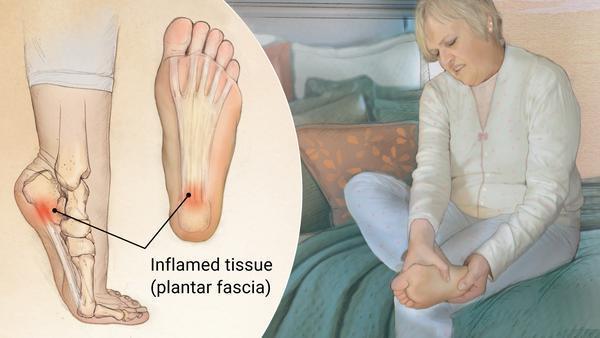Plantar Fasciitis Overview
Plantar fasciitis is one of the most common causes of foot pain in adults. Plantar fasciitis is caused by a strain of the ligaments in an area of the foot called the plantar fascia . The plantar fascia (pronounced FASH-uh) is a thick piece of tissue with long fibers that starts at the heel bone and fans out along the under surface of the foot to the toes. The fascia provides support as the toes bear the body’s weight when the heel rises during walking. Running, jumping, or standing for long periods of time can strain the plantar fascia.
Most people with plantar fasciitis notice improvement in symptoms with or without conservative treatment such as rest, icing, and stretching. Most people are pain-free within a year.
Plantar Fasciitis Symptoms
The most common symptom of plantar fasciitis is pain beneath the heel and sole of the foot. The pain is often worst when stepping onto the foot, particularly when first getting out of bed in the morning or when getting up after being seated for some time. You may have pain in one or both of your feet.
Plantar Fasciitis Risk Factors
Plantar fasciitis is more likely to occur in people whose lifestyle or occupation causes repetitive impact to the heel. Activities such as running, marching, or dancing may trigger or worsen symptoms. Possible other factors that increase the risk of plantar fasciitis include obesity, prolonged standing, and limited ankle flexibility.
Plantar fasciitis occurs more frequently among runners. Although evidence is limited, possible factors that increase the risk in this group include:
- Excessive training (particularly a sudden increase in the distance run)
- Improper running shoes
- Running on unyielding surfaces
- Prolonged standing or walking on hard surfaces
- Flat feet
- High arches
Plantar fasciitis usually occurs in people without underlying medical problems, but it can be associated with other rheumatic disorders such as ankylosing spondylitis or psoriatic arthritis.
Plantar Fasciitis Tests
To diagnose plantar fasciitis, a health care provider will take a medical history and examine your feet to locate painful areas. This involves holding your foot in a flexed position with one hand, and using the other hand to press on different parts of your sole (where the plantar fascia is located). It is important to tell your provider if you have noticed pain or tenderness in other areas not found during the exam.
If you have typical symptoms of plantar fasciitis, then no X-rays or other tests are required. This is the case for most people. In some instances, depending upon the nature and severity of pain as well as other individual factors, your provider may recommend X-rays to determine if another issue (such as a fracture) is causing your pain.

